英美法经典案例解读36页PPT
英美国家法律真实案例(3篇)

第1篇一、引言英美国家作为法治国家的典范,其法律体系和社会治理方式一直以来都备受世界关注。
本文将通过对英美国家几个真实案例的剖析,探讨法律在维护社会正义、保障人权方面的作用,同时也对法律实践中存在的问题进行反思。
二、案例一:辛普森案(1995年)背景:1994年,美国洛杉矶市发生了一起震惊全美的凶杀案,受害者是一位白人妇女。
嫌疑人罗纳德·辛普森,前NFL橄榄球运动员,被控谋杀。
经过一年多的审理,1995年,陪审团最终宣布辛普森无罪。
分析:1. 证据问题:在案件审理过程中,警方在辛普森家中的保龄球道找到了血迹,但后来证明这些血迹并非来自受害者。
此外,警方未能找到确凿的证据证明辛普森有犯罪动机。
2. 种族问题:案件审理期间,媒体和公众普遍关注到案件背后的种族问题。
受害者是一位白人妇女,而嫌疑人是一位黑人男子。
这引发了人们对种族歧视和司法公正的担忧。
3. 陪审团制度:美国采用陪审团制度,陪审团由普通人组成,负责判断被告是否有罪。
然而,在辛普森案中,陪审团成员的背景和立场可能对案件审理结果产生了影响。
结论:辛普森案反映了美国法律制度在证据收集、种族歧视和陪审团制度等方面存在的问题。
尽管最终判决结果为无罪,但这一案件引起了人们对法律公正性的质疑。
三、案例二:弗洛伊德案(2020年)背景:2020年5月,美国明尼苏达州警方在逮捕乔治·弗洛伊德时,将其压在颈部长达8分钟,导致弗洛伊德窒息死亡。
这一事件引发了全美范围内的抗议活动,人们要求警方改革、反对种族歧视。
分析:1. 警察暴力:弗洛伊德案暴露了美国警方暴力执法的问题。
警方在执法过程中,过度使用暴力,侵犯公民权利。
2. 种族歧视:弗洛伊德案再次引发了人们对种族歧视的担忧。
受害者是一位黑人男子,这表明种族歧视问题在美国社会中依然严重。
3. 法律变革:案件发生后,美国多地开始对警方执法进行改革,包括限制警察使用暴力、加强警察培训等。
结论:弗洛伊德案反映了美国社会在警察执法、种族歧视和法律改革等方面存在的问题。
《外国法制史》课件PPT-第12章 美国法
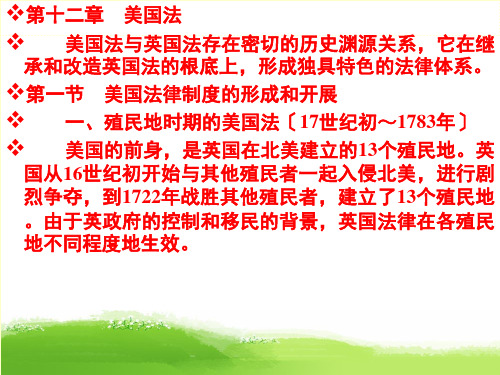
❖ ②?独立宣言?的内容及其历史地位。?独立宣言?由美国的资
产阶级民主派托马斯·杰弗逊等人起草,它以资产阶级启蒙思想 家的“天赋人权〞思想和“社会契约〞论为理论根底,宣称:人 人生而平等,他们都被造物主赋予不可转让的权利,其中包括生 命权、自由权和追求幸福的权利。为了保障这些权利,才在人们 中间成立政府。政府的正当权力,来自于被统治者的同意,如果 政府损害这些目的,人民就有权去改变或者废除它,建立新的政 府。?独立宣言?高举革命的旗帜,列举了英国殖民统治的暴行, 鲜明地表达了资产阶级的革命思想和政治主张。
❖ ③独立后的美国人民同英国的民族矛盾逐渐缓和。
❖第二节 美国法的渊源和特点
❖ 一、美国法的渊源
❖ 1.普通法
❖ 如前所述,基于种种原因,美国最终还是选择普通
法作为美国建立新法律的根底。但是,正如1829年斯托 里大法官在“范内斯诉帕卡德〞一案的判决中指出的: “英国的普通法并不是全部都可以作为美国的普通法, 我们祖先把英国普通法的一般原那么带过来,并且以此 作为他们生来就有的权利,但是他们只带来并采用了适 合他们情况的那一局部。〞
❖ 美国是近代社会第一个通过剧烈的革命性变革实现
资产阶级统治的国家,它的宪法有一系列制度设计,如 分权制衡、正当法律程序、总统制共和政体、联邦制模 式等,对世界上很多国家产生了影响。作为人类法律文 明的成果,它为人类的宪政实践提供了一种可批判性借 鉴的实例。
❖ 二、公司法
❖ 按照美国1787年宪法的规定,有关公司的立法权属于各州的
衡平法之诉〞的区分, 简化了诉讼程序;
❖ 通过制定法消除了土地法的封建因素; ❖在适用“遵循先例〞原那么时,美国法认为,如果固守
先例会不利于案件的公正处理或不利于法律的开展时, 决不恪守先例。
英美法案例
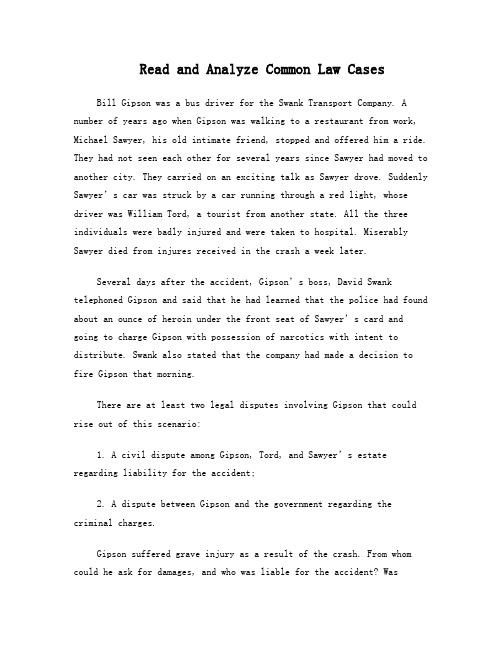
Read and Analyze Common Law CasesBill Gipson was a bus driver for the Swank Transport Company. A number of years ago when Gipson was walking to a restaurant from work, Michael Sawyer, his old intimate friend, stopped and offered him a ride. They had not seen each other for several years since Sawyer had moved to another city. They carried on an exciting talk as Sawyer drove. Suddenly Sawyer’s car was struck by a car running through a red light, whose driver was William Tord, a tourist from another state. All the three individuals were badly injured and were taken to hospital. Miserably Sawyer died from injures received in the crash a week later.Several days after the accident, Gipson’s boss, David Swank telephoned Gipson and said that he had learned that the police had found about an ounce of heroin under the front seat of Sawyer’s card and going to charge Gipson with possession of narcotics with intent to distribute. Swank also stated that the company had made a decision to fire Gipson that morning.There are at least two legal disputes involving Gipson that could rise out of this scenario:1. A civil dispute among Gipson, Tord, and Sawyer’s estate regarding liability for the accident;2. A dispute between Gipson and the government regarding the criminal charges.Gipson suffered grave injury as a result of the crash. From whom could he ask for damages, and who was liable for the accident? WasSawyer at fault? Tord? Was each of them jointly and severally liable? Gipson hired attorney Adrian Neff to represent him. Once Gipson signed a retainer, Neff would later enter an appearance and become Gipson’s attorney of record.Neff, the attorney, then explained that some factors should be considered before deciding on the forum. Gipson may be able to sue in several places: (a) in the state trial court where Gipson lives, (b) in the state trial court where Tord lives, (c) in the state trial court where Sawyer’s estate is located, (d) in the federal district court sitting in Gipson’s state, (e) in the feder al district court sitting in Tord’s state, or (f) in the federal district court sitting in the state where Sawyer’s estate is located. The reason Gipson could sue in a federal district court was the existence of diversity of citizenship. Neff suggested Gipson sue in a federal court. The suit would be brought in the U.S. District Court sitting in Gipson’s own state since this would be the most convenient venue for Gipson.Having decided on a court, Neff started preparation for theincoming suit: he drafted a complaint, the first pleading of the case, naming Gipson as the plaintiff and stated a cause of action in tort for negligence against Tord and Sawyer’s estate as1codefendants. After this issue of law, Neff then summarized and submitted several issue of fact that he felt could establish a cause of action for negligence. Some of the allegations were based upon the knowledge of Gipson, while others were based upon information and belief. The ad damnum clause of the complaint demanded $100,000.00 in damages.Finally, he attached a written demand for a jury trial to the complaint and filed the both documents with the court.The next proceeding is service of process. It was achieved when a copy of the complaint and summons was served on both Tord and the legal representative of Sawyer’s estate. Neff did not served these parties himself; he retained s process server who, after serving the defendants, filed an affidavit of service with the court indicating the circumstances under which the service was accomplished. Service was made before the statute of limitations. Once the defendants were properly served, the court acquired in personam jurisdiction over them. In the pre-trial proceedings that ensued, Tord filed a motion to dismiss, claiming Gipson’s failu re to state a cause of action. The court denied the motion.Because the suit had been brought in the federal court, the governing procedural law would be found in the Federal Rules of Civil Procedure, which provided defendants with two kinds of response: pre-answer motion or answer. If without a pre-answer motion, Tord and Sawyer’s estate must file an answer to Gipson’s complaint within twenty days, according to the Federal Rules of Civil Procedure. Tord filed his answer almost immediately. Since Sawyer was dead and unable to communicate with his attorney about the accident, the attorney for the estate had a number of difficulties in drafting and filing an answer within twenty days. To avoid a default judgment against the estate, the attorney filed a motion asking for an extension of thirty days. The court granted the motion.The answer filed on behalf of Sawyer’s estate denied theallegation of negligence and raised an affirmative defense ofcontributory negligence against Gipson. The estate asserted that if Sawyer had been partially liable for the accident, it was mainly because Gipson had distracted him through his conversation in the car. Certainly, the answer of Sawyer’s estate also stated a cross-claim against codefendant Tord, alleging that the acci dent had been solely by Tord’s negligence. Tord’s answer also raised the defense of contributory negligence against Gipson and cross-claim against Sawyer’s estate, alleging that the accident had been caused solely by the negligence of Sawyer or Sawyer and Gipson together. On this same theory, Tord’s answer also raised a counterclaim against Gipson. At this point, five assorted claim, cross-claims and counterclaims had been filed by the parties with the court. These claims and their relationship to eachother are demonstrated below:1. Plaintiff Gipson’s original complaint for negligence against Tord and against Sawyer’s estate.2. Defendant Tord’s counterclaim for negligence against plaintiff, Gipson.3. Defendant Tord’s cross-claim for negligence against his codefendant,Sawyer’s estate.4. Defendant estate’s cross-claim for negligence against his codefendant, Tord.These three parties were ready to seek discovery. Once their pleadings were filed, each attorney first served written interrogatories on the opposing parties, which were followed by depositions, requestsfor admissions, requests for production, and requests for examination. Tord rejected answering question during his deposition. As a result, Gipson’s attorney had to file a discovery motion named “Motion to Compel”, asking court order compelling Tord to answer. A hearing was then held on Gipson’s motion. After hearing the parties’ argument, the judge granted the motion and ordered Tord to answer those questions. Each party then filed a motion for summery judgment. The judge denied the motions and the case was ready for trial.As the trial date approach, each of the attorneys received a notice requiring them to appear before a magistrate for pretrial conference. During the conference, the magistrate prepared a pretrial statement on the case for the trial judge with the help of the attorneys; the statement contained those facts that had been stipulated, the facts that were still in issue, and a list describing the tangible evidence and witnesses that each attorney intended to introduce during the trial.The case was eventually set for trial. The three parties, their attorneys and the witnesses assembled in the courtroom. The judge, Justice Black White, entered, took the bench, and instructed the bailiff to summon a jury panel for the trial. After the prospective jurors were seated in the jury box,voir dire began. Several jurors were challenged for cause and dismissed. Several other jurors were dismissed as a result of peremptory challenge. A panel of twelve jurors plus two alternates was ultimately selected.After the jury had been seated, Gipson’s attorney rose and asked the judge that he wished invoked the rule on witness. The bailiff ledall witnesses out of the courtroom with the judg e’s instruction. Gipson’s attorney then began the trial with his opening statement to the jury. When he finished, the attorneys for Tord and Sawyer’s estate also delivered their opening statements. Thereafter, Gipson’s attorney began to call his witness as Gipson had the burden of proof. The first witness is a ten-year-old girl who had seen the accident that day. Tord’s attorney quickly rose and asked for bench conference; he declared that he objected to the witness on the basis of competency. The judge overruled the objection upon being satisfied that the witness was old enough to understand the obligation to tell the truth.The jury then was summoned again into the courtroom, and Gipson’s attorney immediately resumed his case in chief with direct examination. After several question, Tord’s attorney again objected on the theory that the child’s answer had not been relevant and therefore not admissible. This time the judge upheld the objection and ordered thejury to disregard the girl’s answer and strike i t from the record. Gipson’sattorney then continued for several questions before announcingthat he had no further question to ask. The attorney for Sawyer’s estate then rose to impeach the girl through cross-examination. Tord’s attorney also conducted a brief cross-examination. There is no re-direct examination.Gipson’s attorney called several other witnesses who had seen the accident. Each witness was examined and cross-examined. Then the judgeannounced a recess for lunch. At 2:00 p.m. sharp, the court was again in session. Neff called his fifth witness, Dr. Jones. After several questions about the doctor’s medical training and experience, Nefffiled a motion that Dr. Jones be qualified as an expert witness and a judicial notice be taken. The judge granted the motion regardless of the objections by either defense counsel. Gipson’s attorney then told the doctor to offer an opinion as to the nature and extent of the injuries that Gipson had suffered from the accident. In order to show Gipson’s medical expenses, Neff also produced the original copies of all medical bills that Gipson had received, under the Best Evidence Rule. The judge ordered the bills be authorized and the clerk to mark the bills as plaintiff’s exhibit number one. After the defense coun sel had inspected the bills, Gipson’s attorney then moved the bills into evidence.After Gipson’s attorney finished his direct examination of hisfinal witness, Gipson himself, the attorney for Sawyer’s estate began cross-examining Gipson and ultimately invoked Dead Man’s Statute against Gipson. During the cross-examination conducted by Tord’s attorney, rules of privilege were invoked by Gipson. Gipson’s attorney then rested his case after all the defense counsels had completed their questions.In the f ollowing morning, the attorney for Sawyer’s estate told the judge that she had a preliminary matter to bring up before the jury was brought into the courtroom. She then proceeded on making a motionfor a direct verdict in favor of the estate. Tord’s attorn ey made a similar motion on behalf of his client. The judge made his decisionafter all the parties’ argument. As to the estate, the judge would neither grant nor deny the motion but would take it under advisement. Asto Tord, the motion was denied because Gipson had produced sufficient evidence to make out a prima facie case of negligence for trial.The jury was brought into the courtroom for the second day of the trial. The attorney for Sawyer’s estate began the trial with an opening statement to the jury. She then called her witnesses individually to conduct her direct examination. It took about half an hour for her to conduct her case. After a lunch recess, Tord’s attorney proceeded to present his case. He had rested his case by late afternoon. The judge dismissed the jury until the following morning. To prepare for jury charge, he also ordered the attorneys to submit any jury instructions that they would like to request and be prepared for closing arguments. Finally, the judge announced that he had dec ided to deny the estate’s earlier motion for a direct verdict. This denial is aninterlocutory court order that cannot be appealed.Closing argument began the following morning; thereafter, each attorney moved for a verdict in favor of his or her client. Then the judge began to charge the twelve jurors as to the law they were tofollow in finding the facts and in reaching a verdict. He explained the concept of burden of proof and illustrated which party has to carry the burden as to each of the elements of negligence. Each element should be proved by a preponderance of the evidence. This was the standard of proof for this sort of case. The jury was then led out of the courtroom to deliberate for a verdict.After about an hour and a half, the bailiff summoned everyone back into the courtroom. The jury came in next. At the request of the court clerk, the foreman rose to read the verdict. On Gipson’s originalcomplaint against Tord for negligence, the jury found for Gipson and against Tord, awarding Gipson $ 40,000.00 in damages. However, on Gipson’s complaint against Sawyer’s estate, the jury decided in favor of the estate, finding that Sawyer had not been negligent. The jury found for the estate on its cross-claim against Tord, the codefendant, awarding $ 80,000.00 damages to the estate. Finally, the jury found against Tord on his cross-claim against the estate, as well as on his counterclaim against Gipson. The judge entered a judgment against Tord in the amounts awarded by the jury. Tord’s attorney made a motion for judgment notwithstanding the verdict, which was denied by the judge immediately. Tord’s attorney then filed a motion for a new trial. When the judge denied his motion again, Tord moved for a reduction of the verdict on the ground that the amounts awarded were excessive. Afterthis last motion had been denied the attorney declared his intention to appeal. The judge granted a stay of the judgment, conditioned upon Tord’s filing a timely notice of appeal and posting the bond.Since Gipson had originally sued for $ 100, 00.00 and the damages awarded by the jury was only $ 40,000.00, Tord felt worried about whether Gipson would later sue him again for the rest the amount originally claimed. His attorney said that Gipson could not sue again on the same cause of action, because Gipson had received a judgment on the merits that would be res judicata. Subsequently, Tord’s attorney filed a notice of appeal with the United States Court of Appeals and posted bond the following week. As attorney for the appellant, he should make sure that the transcripts and copies of exhibits be dispatched to the Court of Appeals and the case docketed by the appellate clerk. Thereafter Tord’s attorney served his appellate brief on the appellees.In response, Gipson and Sawy er’s estate immediately filed their briefs on the issue on appeal.Twenty days passed before the attorneys received a notice that the appeal had been scheduled for an oral argument before the appellate court. Their arguments were heard a few weeks later, and the appropriate standard of review was followed. Six months after the oral argument, the parties received the court’s appellate disposition in the forum of a written opinion. The court affirmed the judgment against Tord, citingthat no reversible trial error was found. Subsequently, Tord petitioned for a rehearing by the court en banc. The petition was denied. Tord followed his attorney’s advice and attempted no further appeal.Nor did he pay the awarded damages immediately either. If Tord were to pursue his case further, he may either petition the U.S. Supreme Courtfor a Writ of Certiorari, or pursue equitable proceedings such as a motion to reopen with the trial court or a Writ of Mandamus with the U.S. Supreme Court. Several days later, Gipson and the estate requested that the clerk of the trial court issue a writ of execution to garnishagainst Tord’s employer for Tord’s wages.When the negligence suit was under day, Gipson had also been involved in a second dispute. Gipson was defending himself in a criminal prosecution for possessing narcotics with intent to distribute. After Gipson had recovered from his injury, two police officers appeared inthe hospital. They produced a warrant and informed Gipson that he was under arrest. Gipson was then taken to the police station after he had been read his rights.The following morning Gipson was taken before a judge for hisinitial appearance (arraignment). The judge told Gipson that he had been charged with a felony, the possession of narcotics with intent to distribute. Because Gipson was unemployed and without adequate funds to pay, a pro bono attorney was assigned to represent him.When the case was recalled in that same morning, the attorney filed a praecipe and formally entered his name as attorney of record for Gipson. The attorney proceeded to discuss the matter of bail. The prosecutor was then given an opportunity to speak. He suggested a high bond for the defendant, who was unemployed and had no close relative in this area. The judge nevertheless agreed to release Gipson on his personal recognizance and set a date for a preliminary hearing the following week. At the preliminary hearing, the only witness was the police officer who had been at the scene of the accident. The policeman said that when he helped pull Gipson out of the car, he found a small paper box sticking out from under the passenger’s side of the front seat. A glassine envelope containing a white powdery substance had spilled out of the box. The substance, about an ounce, was proved to be pure heroin. After Gipson’s attorney cross-examined the policeman briefly, the judge advised that there was probable cause to hold the defendant and ordered the case for grand jury action.After the preliminary hearing, Gipson’s attorney went t o the prosecutor in order to convince him to enter a nolle prosequi on the charge, explaining that Gipson had simply been offered a ride home and was not aware of the fact that the heroin was in the car. The prosecutor refused to drop the charge unconditionally. Instead, he was willing to drop the felony charge if Gipson would agree to plead guilty to lesseroffense of simple possession of drug, a misdemeanor. Then Gipson’s attorney told him about plea bargaining session and advised him to accept the prosec utor’s offer. After a long private discussion with his attorney, on matters such as possible felonyconviction and habeas corpus, Gipson said he was innocent and could not plead guilty, even to a misdemeanor. Three weeks went by before Gipson’s attorney was informed that the grand jury had returned an indictment against Gipson. The next proceeding would be the arraignment the following week. On the date of arraignment, Gipson was formally noticed of the indictment and the judge then set a date for trial.The day of trial arrived. Voir dire had been held before a jury was impaneled. The prosecutor and Gipson’s attorney presented their opening statements respectively and then introduced their witnesses. Gipson was the only witness for his attorney. Afterwards the prosecutor rose and advised the jury that Gipson had a previous conviction for shoplifting and received a sentence for two years in prison. Gipson’s attorney successfully objected that the conviction, which had happened eleven years before, should not used to impeach Gipson’s testimony. The prosecutor concluded his cross-examination after a few more questions. Following the lunch recess, both sides made their closing arguments. The judge then instructed the jury that the burden of proof in a criminal case is on the government (here, the prosecutor). He explained that the burden is to prove element of the offense beyond a reasonable doubt. It took the jury an hour to reach its verdict that Gipson be acquitted of the offense. A poll of the jury, which had been requested by the prosecutor, confirmed the result, and the judge told Gipson that he wasfree. However, this result did not render Gipson’s potential suit against his employer moot, and he was still trying to get his job back.。
英美法经典案例解读
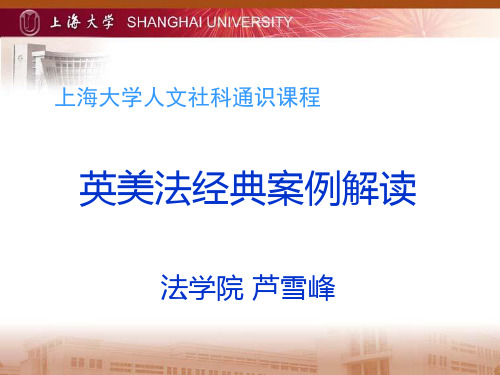
开庭审理:辩方反驳
第一,辛普森虽对妮克有过不当行为,但并不能因此推断 辛杀人。
犯罪专家指出这样的推断很少成立。妮克本身并不清白, 偷税漏税,而且吸毒。此次被害很可能是与毒品有关。再 说辛仍爱妮克,辛几次对痛打妮表示忏悔。当听到妮
被杀的消息后,非常悲痛。检方指出的动机不能成立。
开庭审理:辩方反驳
法理沉思
一、关于“超越合理怀疑”
在美国的司法制度中,刑事案采用的定罪标准是 “超越合理怀疑”。具体而言,在法庭审判时,检 方若要指控被告有罪,一定要提出确凿可信的证据 来证明被告的罪行。陪审团在裁决无罪时不一定非 要确信被告清白无辜,只要检方呈庭证据破绽较多, 没有“超越合理怀疑”的严格标准,尽管有很多迹 象表明被告涉嫌犯罪,但陪审团仍然可以认定被告 无罪。
: 另外,在美国的刑事案审判中,12名陪审员中只要有1人 持有异议,就会出现“死锁”(Dead Lock)现象,即所 谓“悬而未决的陪审团”;在此情况下,不得实行少数服 从多数而作出判决,而必须重选陪审员,重组陪审团,并 重新开庭。 所以,辛普森案陪审团做出被告无罪的一致判决,与黑人 构成陪审团主体并无绝对和必然的关系。
庭外评论:众说纷纭
辛普森是个有钱的富豪,“有钱能使鬼推磨”, 所以事情办成了。
异议者:有钱未必能使鬼推磨。若是论有钱,大名鼎鼎的 拳王泰森(Mike Tyson)比淡出体坛多年的辛普森有钱得 多,可是1997年泰森因涉嫌强奸遭到起诉后,尽管他同样 花费天文价格聘请了一帮名律师为他出庭辩护,但仍然无 法摆脱被定罪的命运,被判了6年监禁。况且美国的制度决 定了辛普森案的陪审员不可能被贿赂。随机抽名临时组成 并与世隔绝,还有一票否决制,在物质高度发达的美国, 要临时抱佛脚去贿赂陪是不可能的。陪审团主要负责认定 事实,法官负责量刑。
外国法制史之英美.ppt
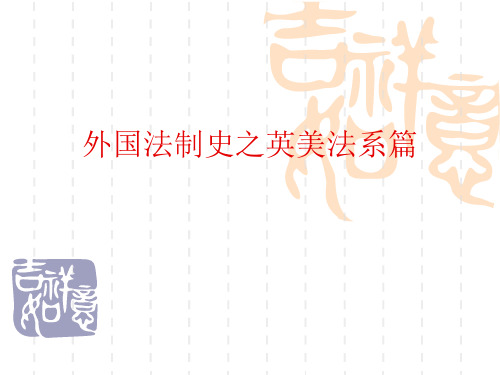
▪ 第十讲、英国法 ▪ 重点问题: ▪ 1、普通法和衡平法的形成和发展 ▪ 2、普通法的特点和原则 ▪ 3、衡平法的特点和影响 ▪ 4、英国宪法的基本原则 ▪ 5、英国的陪审制度和律师辩护制度
▪ 一、英国法的形成和发展:
▪ 1、诺曼征服前(5世纪-1066年)盎格 鲁·撒克逊习惯法到成文化阶段“蛮族法 典”。
▪ 选举制的改革,增加资产阶级名额,财产限制放松,公 开投票制。
▪ 制定法数量大增; ▪ 对法院组织和程序法进行改革,1873年、1875年《司法
法》结束了普通法院和衡平法院分立对峙局面。
▪ 5、当代英国法的发展: ▪ 立法程序简化,委托立法大增; ▪ 完善选举制; ▪ 社会立法加强; ▪ 欧盟法成为英国法的重要渊源。
▪ 3、英国宪法的特点: ▪ (1)历史延续性 ▪ (2)内容不确定性 ▪ (3)柔性宪法
▪ 四、行政法: ▪ 1、行政法概念—支配行政活动的法律。没有公法和私法
之分。 ▪ 2、行政法特点—由普通法院管辖,没有行政法院系统;
适用一般法律原则。 ▪ 3、基本原则: ▪ 越权无效; ▪ 行政行为合理原则:以公共利益和正当理由为依据,防
▪ 遗嘱继承书面形式,由遗嘱人签字或在其监督下他人代签, 两个证人证实。
▪ 1938年前遗嘱绝对自由,后规定未亡配偶、未成年子女或 无生活能力的子女有权得到必要的保障;非婚生子女也从 遗产中可获得抚养费。
▪ 无遗嘱继承人生存配偶、生存子女、生存父母、其他近亲, 无主归国家所有。
▪ 九、刑法: ▪ 1、概述 ▪ 至今仍然没有成文刑法典。 ▪ 盎格鲁·撒克逊时代就存在血亲复仇或赎罪金的方
▪ 二、英国法的渊源: ▪ 1、普通法:指由普通法院创立并发展起来的一
英美刑法案例解析
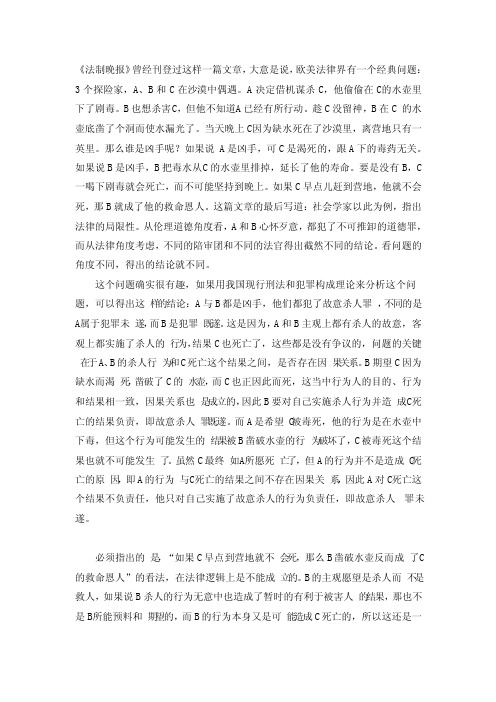
《法制晚报》曾经刊登过这样一篇文章,大意是说,欧美法律界有一个经典问题:3个探险家,A、B和C在沙漠中偶遇。
A决定借机谋杀C,他偷偷在C的水壶里下了剧毒。
B也想杀害C,但他不知道A已经有所行动。
趁C没留神,B在C 的水壶底凿了个洞而使水漏光了。
当天晚上C因为缺水死在了沙漠里,离营地只有一英里。
那么谁是凶手呢?如果说 A是凶手,可C是渴死的,跟A下的毒药无关。
如果说B是凶手,B把毒水从C的水壶里排掉,延长了他的寿命。
要是没有B,C 一喝下剧毒就会死亡,而不可能坚持到晚上。
如果C早点儿赶到营地,他就不会死,那B就成了他的救命恩人。
这篇文章的最后写道:社会学家以此为例,指出法律的局限性。
从伦理道德角度看,A和B心怀歹意,都犯了不可推卸的道德罪,而从法律角度考虑,不同的陪审团和不同的法官得出截然不同的结论。
看问题的角度不同,得出的结论就不同。
这个问题确实很有趣,如果用我国现行刑法和犯罪构成理论来分析这个问题,可以得出这样的结论:A与B都是凶手,他们都犯了故意杀人罪,不同的是A属于犯罪未遂,而B是犯罪既遂。
这是因为,A和B主观上都有杀人的故意,客观上都实施了杀人的行为,结果C也死亡了,这些都是没有争议的,问题的关键在于A、B的杀人行为和C死亡这个结果之间,是否存在因果关系。
B期望C因为缺水而渴死,凿破了C的水壶,而C也正因此而死,这当中行为人的目的、行为和结果相一致,因果关系也是成立的,因此B要对自己实施杀人行为并造成C死亡的结果负责,即故意杀人罪既遂。
而A是希望C被毒死,他的行为是在水壶中下毒,但这个行为可能发生的结果被B凿破水壶的行为破坏了,C被毒死这个结果也就不可能发生了。
虽然C最终如A所愿死亡了,但A的行为并不是造成C死亡的原因,即A的行为与C死亡的结果之间不存在因果关系,因此A对C死亡这个结果不负责任,他只对自己实施了故意杀人的行为负责任,即故意杀人罪未遂。
英国美国的法律案例分析(3篇)

第1篇一、案件背景美国诉麦当劳案(United States v. McDonald's Corporation)是美国历史上一起重要的消费者权益保护案件。
该案主要涉及麦当劳公司在其快餐产品中使用的化学添加剂,包括磷酸盐、焦糖色素、味精等。
原告认为这些添加剂对人体健康有害,麦当劳公司未充分告知消费者,违反了消费者权益保护法。
以下是具体案情。
二、案情概述原告是美国消费者联盟(Consumer Federation of America)和多个消费者组织,被告为麦当劳公司。
原告指控麦当劳公司在其快餐产品中使用磷酸盐、焦糖色素、味精等化学添加剂,这些添加剂对人体健康有害。
原告认为,麦当劳公司未在产品标签上注明这些添加剂的使用,违反了消费者权益保护法。
此外,原告还指控麦当劳公司在广告宣传中误导消费者,声称其产品安全无害。
三、案件审理1. 地区法院审理地区法院审理过程中,原告提交了多项证据,包括专家证词、研究报告等,证明磷酸盐、焦糖色素、味精等添加剂对人体健康可能产生负面影响。
然而,被告辩称这些添加剂在食品工业中普遍使用,且符合相关法规标准。
地区法院最终判决麦当劳公司无罪。
2. 上诉法院审理原告不服地区法院的判决,向上诉法院提起上诉。
上诉法院审理过程中,双方就添加剂的使用、消费者权益保护法等相关问题进行了辩论。
上诉法院认为,地区法院在审理过程中存在事实认定错误,遂撤销原判,发回重审。
3. 重审法院审理重审法院在审理过程中,重新审查了原告提交的证据。
最终,法院认为原告未能提供充分证据证明添加剂对人体健康有害,且麦当劳公司已在其产品标签上注明了添加剂的使用。
因此,法院再次判决麦当劳公司无罪。
四、案件评析1. 消费者权益保护法美国诉麦当劳案体现了消费者权益保护法在食品领域的应用。
消费者权益保护法旨在保护消费者在购买、使用商品或接受服务过程中的合法权益。
本案中,原告指控麦当劳公司未充分告知消费者添加剂的使用,违反了消费者权益保护法。
英美法律经典案例分析(3篇)

第1篇案例背景:R v. Morgan 是一起在英国法律史上具有重要意义的案例,涉及到了自卫权和误认防卫的概念。
此案发生在1978年,由英国上议院审理。
案情简介:本案中,被告Morgan在自家的花园中,看到一名男子(受害人)闯入他的私人领地。
Morgan误以为该男子是企图闯入他家的窃贼,于是从家中拿出一把枪,对准了男子。
在紧张的情绪下,Morgan扣动了扳机,不幸的是,子弹击中了受害人的胸部,导致其死亡。
在审理过程中,Morgan声称自己是在自卫的情况下开枪,并认为自己的行为符合法律规定的自卫权。
然而,陪审团却认为Morgan的行为超出了法律规定的自卫范围,最终判决Morgan犯有过失杀人罪。
上诉过程:Morgan不服一审判决,向英国上诉法院提出了上诉。
上诉法院认为,在Morgan的情况下,他误认了受害人的身份和动机,因此他的行为不能被认定为合法的自卫。
然而,上诉法院也认为,Morgan在当时的紧张情绪下,可能无法准确判断受害人的真实意图,因此他的行为不能被认定为故意杀人。
最终判决:英国上议院审理了此案,并作出了最终判决。
上议院认为,Morgan在误认受害人的情况下开枪,其行为虽然不符合自卫权的条件,但也不能被认定为故意杀人。
上议院认为,Morgan的行为构成了一种过失杀人,因此维持了上诉法院的判决。
案例分析:1. 自卫权的概念:自卫权是英国法律中的一项基本原则,它允许个人在遭受非法攻击或面临生命危险时采取必要的行动来保护自己。
在本案中,Morgan声称自己是在自卫的情况下开枪,但他的行为是否构成合法的自卫,成为本案的核心争议。
2. 误认防卫:误认防卫是指个人在自卫过程中,错误地认为对方构成了攻击,从而采取防卫行为。
在本案中,Morgan误以为受害人是企图闯入他家的窃贼,因此采取了防卫措施。
上议院认为,Morgan的误认是合理的,因为他在紧张的情绪下无法准确判断受害人的真实意图。
3. 自卫权的范围:自卫权并非没有限制,个人在行使自卫权时,必须遵守一定的法律原则。
2019英美法系.ppt

英美法系其他解释规则
合同的目的 - Glynn v. Margetson (准许绕航条款) 合同的解释不利于起草者 解释应当以促成合同成立为主 议定条款优于格式条款, 版本优先规则 - 同一份合同, 铅印本与打印本内容发生冲突 时, 以打印本为准; 打印本与手写本内容发生冲突时, 以手写 本为准。如果同一合同, 部分内容是打印, 部分内容是手写, 两者冲突,则以手写记载为准。 数字文字优先规则。同一份合同中, 数字兼用英文数字与阿 拉伯数字书写的, 二者相冲突时, 以英文数字为准。
第4.3条 在适用本章第4.1条和4.2条时,应 考虑到所有情况,包括: (a)当事人之间的初期谈判; (b)当事人之间已确立的习惯做法; (c)合同订立后当事人的行为; (d)合同的性质与目的; (e)在所涉交易中,通常赋予合同条款和 表述的含义; (f)惯例。
1.A为写一本书与出版商B签了一份合同,合同规定 该书“约300页”。在谈判中,B使A确信对页数的 大致规定是出于行政管理的需要,A不受准确页数的限 制,如果需要可以超过。A提交了一份500页的手稿。 是否违反合同? 2.A是加拿大制造商,B是美国零售商。A和B就向 B交付光学镜头订立了一批合同,合同一直是以加拿大 元计价。A向B发出一新的要约,提示以“元”计价, B主张该要约的计价单位应当以美元,双方对此发生争 议。 3.A和B订立了一份销售一船石油的合同,每桶油价 20.5美元。后来,双方当事人未能就所欲使用的油 桶型号达成一致,A希望每桶42标准加仑,B则希望 每桶36英国法定标准加仑。
口头证据原则不适用的情形:
没有最终完整的书面合同的场合。 口头证据产生于书面合同签订之后。 口头证据是用来否定合同合法有效的场合。 并不排除当事人用商业惯例,交易过程或履约过 程开对合同条款的不明之处作出顺理成章的合同 解释, 却不能用它们来罢黜合同条款的规定。
英美保险法经典案例解析

①陈欣:《保险法》(第三版),北京大学出版社2010年版,第2页。
②韩世远:《合同法总论》(第二版),法律出版社2008年版,第33页。
③黎建飞、王卫国:《保险法教程》,北京大学出版社2009年版,第83页。
④温世扬主编:《保险法》,法律出版社2003年版,第38页。
⑤对于该案有观点认为,曼斯菲尔德只是强调保险合同需要当事人的诚信,并未言及最大诚信。
韩永强:“保险合同法最大诚信原则的祛魅”,载《甘肃政法学院学报》2011年第3期。
⑥Carter v Boehm (1766)3Burr 1905,1910-12.近代保险发源于英国,18世纪的工业革命极大地促进了英国保险业的发展,完备的现代保险法和保险法律制度也首先出现在英国。
英国的保险立法过程始于18世纪中叶并一直持续到20世纪。
①美国是全球最大的单一保险市场,其保险法也较为发达,在其保险业和保险法的发展过程中,一些案例起到了里程碑式的作用。
了解这些经典的案例,对于研究保险法上的一些重要制度的建立和沿革有重要的借鉴意义。
在我国的保险法研究领域,大多只是引用这些案例,而没有对这些案例的案情进行介绍及对保险制度建立和推动作用进行研究。
笔者试图在此方面有所作为,以期为保险法的研究和保险纠纷案件审判实务提供参考。
一、有关最大诚信原则的案例解析诚实信用原则是民商法的基本原则,它要求人们在市场活动中讲究信用,恪守诺言,诚实不欺,在不损害他人利益和社会利益的前提下追求自己的利益。
②保险是转移和抵销风险的经济活动,保险合同是典型的射幸合同,保险人是否履行赔偿或给付保险金的义务取决于保险事故是否发生;保险人赔偿或给付的保险金通常远远大于投保人支付的保险费,两者之间没有等价交换关系。
③保险和保险合同的上述特点,使得保险领域较易发生欺诈等违背诚信原则的行为,继而决定了法律对保险活动的诚信要求较一般民事活动更高,即保险合同的双方当事人在保险合同的订立和履行过程中,必须以最大的诚意履行自己的义务,互不欺骗和隐瞒,恪守合同的约定。
权利英美法讨论 PPT资料共36页

• The confusion in this area is encouraged by the use of rights rhetoric in political discourse (more prevalent in the United States than in most other countries).
Reporter: Liu, Xian Gang China University of Political Science and Law
• According to some commentators, ancient Roman Law and medieval legal systems had no concept that compared to the modern notion of “rights”. The closest analogue, “ius” referred instead to “the right thing to do ” or “ what is due according to law”.
• Of course, deciding that a certain type of entity (e.g. a fetus) can have (moral or legal) tights is different from saying that fetuses do have such rights.
• This mixes two levels of discussion, two different types of questions.
Байду номын сангаас
• It is compatible to say both: (1) (as a conceptual matter) I do not think it makes sense to speak of fetuses as having rights; and (2) (as a matter of policy or morality) I believe that abortion is wrong and immoral because it involves severely harming fetuses, which should not be allowed except in the most extreme circumstances.
英美法律经典案例分析(3篇)
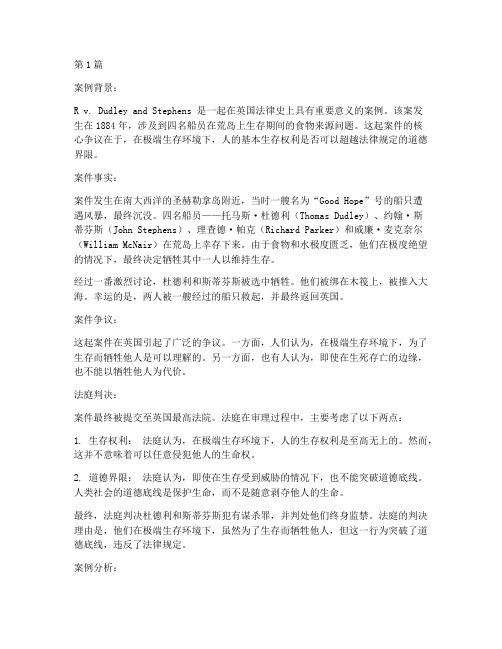
第1篇案例背景:R v. Dudley and Stephens 是一起在英国法律史上具有重要意义的案例。
该案发生在1884年,涉及到四名船员在荒岛上生存期间的食物来源问题。
这起案件的核心争议在于,在极端生存环境下,人的基本生存权利是否可以超越法律规定的道德界限。
案件事实:案件发生在南大西洋的圣赫勒拿岛附近,当时一艘名为“Good Hope”号的船只遭遇风暴,最终沉没。
四名船员——托马斯·杜德利(Thomas Dudley)、约翰·斯蒂芬斯(John Stephens)、理查德·帕克(Richard Parker)和威廉·麦克奈尔(William McNair)在荒岛上幸存下来。
由于食物和水极度匮乏,他们在极度绝望的情况下,最终决定牺牲其中一人以维持生存。
经过一番激烈讨论,杜德利和斯蒂芬斯被选中牺牲。
他们被绑在木筏上,被推入大海。
幸运的是,两人被一艘经过的船只救起,并最终返回英国。
案件争议:这起案件在英国引起了广泛的争议。
一方面,人们认为,在极端生存环境下,为了生存而牺牲他人是可以理解的。
另一方面,也有人认为,即使在生死存亡的边缘,也不能以牺牲他人为代价。
法庭判决:案件最终被提交至英国最高法院。
法庭在审理过程中,主要考虑了以下两点:1. 生存权利:法庭认为,在极端生存环境下,人的生存权利是至高无上的。
然而,这并不意味着可以任意侵犯他人的生命权。
2. 道德界限:法庭认为,即使在生存受到威胁的情况下,也不能突破道德底线。
人类社会的道德底线是保护生命,而不是随意剥夺他人的生命。
最终,法庭判决杜德利和斯蒂芬斯犯有谋杀罪,并判处他们终身监禁。
法庭的判决理由是,他们在极端生存环境下,虽然为了生存而牺牲他人,但这一行为突破了道德底线,违反了法律规定。
案例分析:R v. Dudley and Stephens 案例是一起典型的英美法律经典案例分析。
以下是对该案的分析:1. 生存权利与生命权:该案突显了生存权利与生命权之间的矛盾。
